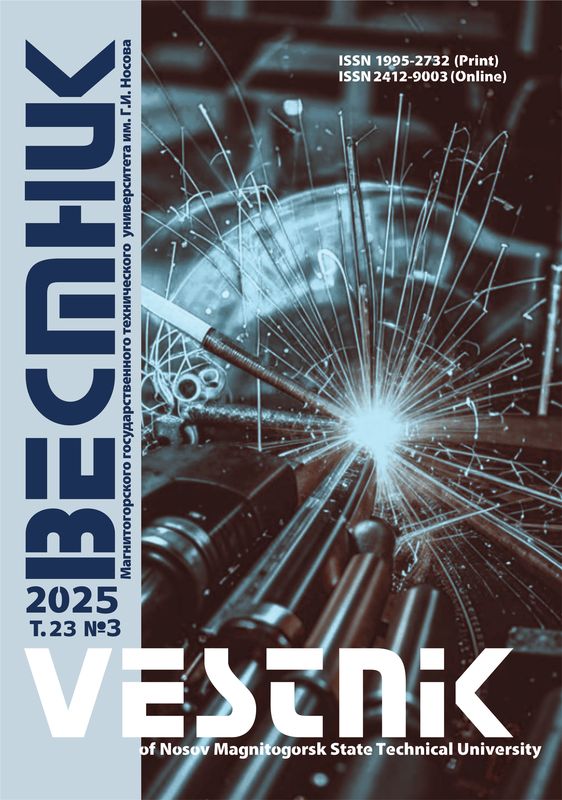DOI: 10.18503/1995-2732-2021-19-2-40-49
Abstract
This paper is devoted to the study of the microstructure and properties of composite coatings of the Cu-W system applied by cold gas-dynamic spraying (CS). The process under consideration makes it possible to obtain high-quality coatings from different types of materials. CS is widely used and studied due to its technological simplicity, a wide range of sprayed materials and operating temperatures. In this process, a particle hits the substrate at high velocity to produce a strong plastic deformation and then creates a coating. Due to lower temperature and higher velocity than thermal spraying, the cold spray process is increasingly being used in the industry for protective coatings. The characteristics of particle deposition and coating formation in cold spraying are different from thermal spraying. Many theoretical studies of the cold spray process have contributed to the development of high performance coatings, making cold spray a popular research area. However, there are some technological challenges that arise when spraying low melting point materials. During softening, particles stick to the walls of the tooling (nozzle) and block spraying. In practice, this problem is solved by adding ceramic particles and spraying powder mixture. As a result, the formed coating will have better mechanical properties, and the technological problem will be solved. The paper summarizes the results of microstructure studies and practical experiments and compares them with other methods of coating deposition. The experimental method of sample preparation and the equipment used are given. The paper shows the microstructure before and after thermal treatment of sprayed samples, and measurements of microhardness and thermal conductivity.
Keywords
Cold gas-dynamic spraying, coating, copper, tungsten, powder.
For citation
Latfulina Yu.S., Doubenskaia M., Samodurova M.N., Trofimov E.A., Barkov L.A. Implementation of a Copper- Tungsten Coating by Cold Gas-Dynamic Spraying. Vestnik Magnitogorskogo Gosudarstvennogo Tekhnicheskogo Universiteta im. G.I. Nosova [Vestnik of Nosov Magnitogorsk State Technical University]. 2021, vol. 19, no. 2, pp. 40–49. https://doi.org/10.18503/1995-2732-2021-19-2-40-49
1. Alkhimov A.P., Klinkov S.V., Kosarev V.F., Fomin V.M. Kholodnoe gazodinamicheskoe napylenie. Teoriya i praktika: Monografiya [Cold gas-dynamic spraying. Theory and practice: monograph]. Moscow: Fizmatlit, 2009, 535 p. (In Russ.)
2. Robitaille F., Yandouzi M., Hind S., Jodoin B. Metallic coating of aerospace carbon/epoxy composites by the pulsed gas dynamic spraying process. Surf. Coat. Technol. 203, 2954–2960 (2009).
3. Lupoi R., O'Neill W. Deposition of metallic coatings on polymer surfaces using cold spray. Surf. Coat. Technol. 205, 2167–2173 (2010).
4. Zweben C. Metal-matrix composites for electronic packaging. The Journal of The Minerals, Metals & Materials Society, 44–7, 15–23 (1992).
5. Kang H.-K., Kang S.B. Tungsten/copper composite deposits produced by a cold spray. Scripta Materialia, 49, 1169–1174 (2003).
6. Kang S.B., Kang H.-K., Euh K. Processing and microstructures of tungsten/copper composites produced by plasma spray and cold spray. Materials Science Forum, 475–479, 945–948 (2005).
7. Dong L.L., Ahangarkani M., Chen W.G., Zhang Y.S. Recent progress in development of tungsten-copper composites: Fabrication, modification and applications. Int. J. of Refractory Metals and Hard Materials, 75, 30–42 (2018).
8. Cold spray. A guide to best practice. 2012, Arbegast Materials Processing and Joining Lab: South Dakota School of Mines and Technology, United States.
9. Hussain T., McCartney D.G., Shipway P.H., Zhang D. Bonding mechanisms in cold spraying: the contributions of metallurgical and mechanical components. J. Therm. Spray Technol. 18 (3), 364–379 (2009).
10. Huang R., Ma W., Fukanuma H. Development of ultra-strong adhesive strength coatings using cold spray. Surface and Coatings Technology, 258, 832–841 (2014).
11. Sova A., Maestracci R., Jeandin M., Bertrand Ph., Smurov I. Kinetics of composite coating formation process in cold spray: Modelling and experimental validation. Surface and Coatings Technology (2016).
12. Goldstein J., Newbury D. Scanning electron microscopy and X-ray microanalysis. Kluwer, 2003, 689 p.
13. ISO 6507-1:2005 Metallic materials. Vickers hardness test. Part 1: Test method.
14. Calvet Calorimeter C80. From ambient to 300°C by Setaram 2019 (SETARAM Instrumentation, available at: www.setaram.com).
15. Akulov A.I., Alekhin V.P., Ermakov S.I. et al. Tekhnologiya i oborudovanie svarki plavleniem i termicheskoy rezki [Technology and equipment for fusion welding and thermal cutting]. Moscow: Mashinostroenie, 2003, 560 p. (In Russ.)
16. Talbot D.E.J. Effects of hydrogen in aluminium, magnesium, copper, and their alloys. International Metallurgical Reviews, 1975, no. 20(1), pp. 166–184.
17. Manchang G., Suk B.K., Kwangjun E. Thermal conductivity of Al–SiCp composites by plasma spraying. Scripta Materialia, 52, 51–56 (2004).
18. Incropera F.P., DeWitt D.P., Bergman T.L., Lavine A.S. Fundamentals of heat and mass transfer. John Wiley & Sons, 2011, 1024 p.












